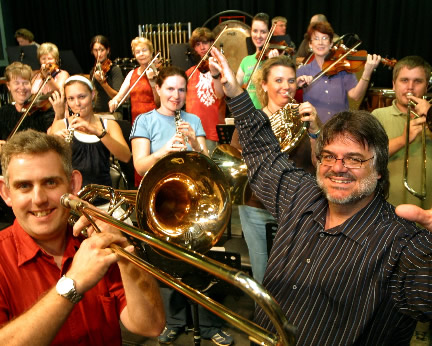Moving Images
Symphony in the Gardens

Presented by the Darwin Symphony Orchestra with Guest Conductor
Simone De Haan.
Guest Conductor for this DSO outdoor concert, Professor Simone
de Haan, has chosen a dynamic programme for Moving Images
on Saturday 27th August. Collaborations with Milingimbi and
Maningrida communities, Miny’tji and Marrangu Manikay
Bundurr, provide the centrepiece, displaying a special connection
between the orchestra and indigenous performers.
The evening’s intense journey of rhythm and pulse also
features Short Ride in a Fast Machine by John Adam, the most
popular orchestral work by a contemporary American composer
and Christopher Brubeck’s jazz and blues influenced
Concerto for Bass Trombone and Orchestra with the DSO’s
Assistant Conductor and trombonist Andrew Snell.
RPM by Matthew Hindson challenges the orchestra to ‘rock
and roll’ and lyrical scores from movies by Australian
composers provide the opportunity for the audience to create
their own images as they listen to what have now become film
classics - the evocative Man from Snowy River by Bruce Rowland
and numbers from Babe by Nigel Westlake.
Peter Sculthorpe’s Earthcry will be enhanced by one
of Australia's finest traditional didgeridoo players, guest
artist, William Barton. William has this year performed at
the 90th Anniversary of Gallipoli at Anzac Cove, with the
London Philharmonic Orchestra at the Royal Festival Hall and
also in Guitars Under the Southern Stars on the Palmerston
campus. He is renowned for his work with orchestras, choral
directors and composers in Australia, America and Europe,
developing new commissions and creating a strong and positive
sustainable future for the yidaki (the didgeridoo).
Moving Images promises to be a truly memorable concert by
the Darwin Symphony Orchestra - a genuine musical connection
and a sensuous journey into the world of contemporary music
making.
Programme:
Short Ride in a Fast Machine [Fanfare for Great Woods] by
John Adams
Irish Tune from County Derry by Percy Grainger
Miny’tji by Marcus Dhurrkay, arranged and orchestrated
by Scott Trenwith
Billy the Kid - Prairie Night and Celebration Aaron Copland
Marrangu Manikay Bundurr by Don Weluk & Lindsay Mace,
arranged and orchestrated by Scott Trenwith
Concerto for Bass Trombone and Orchestra by Christopher Brubeck
Moving Pictures by Nigel Westlake
RPM by Matthew Hindson
Earthcry (abridged) by Peter Sculthorpe
The Man from Snowy River (Concert Suite) by Bruce Rowland
INTRODUCTION TO MINY’TJI
Miny’tji is a word and concept so central to Yolngu
culture that it is virtually impossible to succinctly translate
into any other language. Miny’tji means art, design,
colour, picture, painting. Miny’tji are the Sacred and
spiritually significant clan designs for particular country
sites heavily loaded with the weight of the Ancestors. Considered
one of the most Sacred representations of the world, Miny’tji
is in the octopus (Ngarrpiya), the sunset (Ojapano) and the
whale (Wuymirri).
Miny’tji embodies an expansive Yolngu concept and Scott
Trenwith’s adaptation of the Arnhemland funeral ceremony
and festival song succeeds in translating Miny’tji,
by fusing Yolngu culture, history and discourse with the full
symphony orchestra, thus making it accessible to the audience
in Darwin.
MINY’TJI
Miny’tji (pronounced “meen-chi”) is a music/dance
piece currently much performed at N/E Arnhemland music festivals
and funeral ceremonies. Indeed, it was recorded for the present
orchestration whilst Marcus Dhurrkay, the singer/composer
was at Milingimbi after being brought
there from his home at Galiwin’ku to perform it for
a funeral.
These funerals last for several days whilst the traditional
song-lines related both totemically and geographically to
the deceased are performed. This is to send the spirit of
the deceased on a journey back to its place of origin –
generally a totemic waterhole or special place on the land
or in the ocean. On the last day of the funeral, before and
after the coffin is moved from its paperbark shade for burial,
a Christian service is generally held. These services are
now often accompanied by a fusion performance piece –
fusing both Christian/Totemic concepts and Western/Yolngu
music/dance forms. Miny’tji is such a work.
Miny’tji here essentially means ‘colour’
and the piece concerns the colours of three related Dreamings
of the Wangurri and Warramiri clans: Ngarrpiya (Octopus),
Wuymirri (Whale) and Djapana (Sunset). Ngarrpiya and Wuymirri
both originate from Marchinbar Island – one of the Wessel
Islands group, north of Galiwin’ku, It is said that
the deep shimmering colours of both the Octopus skin and ink,
the refracted colours of the Whale’s oil (essence) floating
on water and the changing, glowing colours of the Sunset are
all deeply and essentially related. The singer prays to be
filled with the purity and iridescence of these colours. He
sings that he will follow the north wind (Lunggurrma) –
back to the place of origin in the Wessel Islands –
back to God.
Many of the dance gestures, movements and vocalised sounds
are directly taken from the traditional bunggul (ceremony)
for Ngarrpiya, Djapana, Lunggurrma (North Wind) and Djarrami
(mirror - from the Macassans). The orchestration is a rendering
of Marcus’ keyboard playing and sequencing as recorded
at Milingimbi.
Bring your own esky, rug, picnic
Date: 27 Aug
Time: 6.30pm. Gates open 5.30pm
Venue: Gardens Amphitheatre
Price: $20
Bookings: 8980 3333. Tickets also available
at the gates from 5.30pm.
Full Details: DSO 8946 6488
|